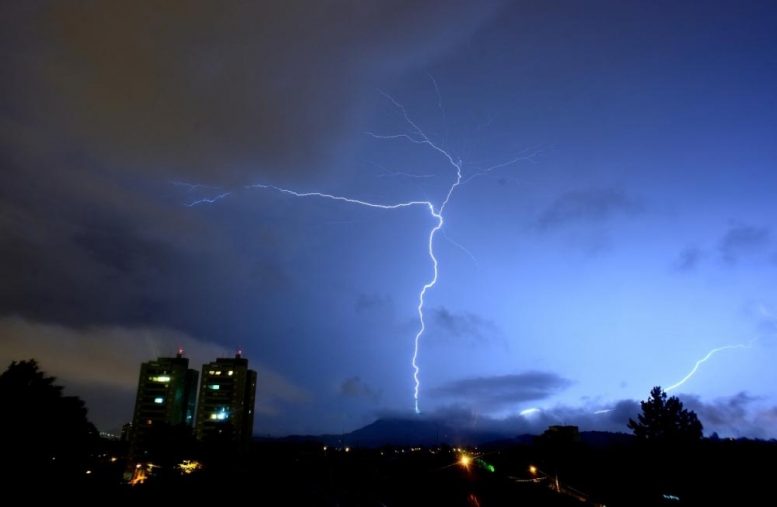
Analysis of the first super slow motion recordings of upward flashes suggests a possible explanation for the formation of luminous structures after electrical discharges split in the atmosphere. Credit: INPE
Analysis of the first super slow motion recordings of upward flashes suggests a possible explanation for the formation of luminous structures after electrical discharges split in the atmosphere.
Researchers at Brazil’s National Space Research Institute (INPE), in partnership with colleagues in the United States, United Kingdom, and South Africa, have recorded for the first time the formation and branching of luminous structures by lightning strikes.
Analyzing images captured by a super slow motion camera, they discovered why lightning strikes bifurcate and sometimes then form luminous structures interpreted by the human eye as flickers.
The study was supported by FAPESP. An article outlining its results is published in Scientific Reports.
“We managed to obtain the first optical observation of these phenomena and find a possible explanation for branching and flickering,” Marcelo Magalhães Fares Saba, principal investigator for the project, told Agência FAPESP. Saba is a researcher in INPE’s Atmospheric Electricity Group (ELAT).
The researchers used ultra high-speed digital video cameras to record more than 200 upward flashes during summer thunderstorms in São Paulo City (Brazil) and Rapid City, South Dakota (USA) between 2008 and 2019. Upward lightning strikes start from the top of a tall building or other ground-based structure and propagate upward to the overlying cloud.
The upward flashes they recorded were triggered by positively charged cloud-to-ground lightning discharges, which are much more common, as described by the same INPE research group in a previous study.
“Upward lightning originates at the top of a tower or the lightning conductor on a skyscraper, for example, when the storm’s electrical field is disturbed by a cloud-to-ground discharge as far away as 60 kilometers,” Saba said.
Although the study conditions were very similar in Brazil and the US, luminous structures were observed in only three upward flashes, recorded in the US. These were formed by a positive leader discharge propagating toward the cloud base.
“The advantage of recording images of upward lightning is that they let us see the entire trajectory of these positive leaders from ground to cloud base. Once inside the cloud, they can no longer be seen,” Saba said.
The researchers found that a low-luminosity discharge with a structure resembling a paintbrush sometimes forms at the tip of the positive leader. “We observed that this discharge, often referred to as a corona brush, may change direction, split in two, and define the path of the lightning flash and how it branches,” Saba said.
When an upward flash branches successfully, it may proceed to the left or right. When branching fails, the corona brush may give rise to very short segments as bright as the leader itself. These segments first appear milliseconds after the corona brush splits, and pulsate as the leader propagates upward toward the cloud base, the videos show.
“The flickers are recurring failed attempts to start a branch,” Saba said, adding that the flickers may explain why multiple lightning discharges are frequent, but more studies are needed to verify this theory.
Reference: “Optical observation of needles in upward lightning flashes” by Marcelo M. F. Saba, Amanda R. de Paiva, Luke C. Concollato, Tom A. Warner and Carina Schumann, 15 October 2020, Scientific Reports.
DOI: 10.1038/s41598-020-74597-6









Be the first to comment on "Researchers Discover Why Lightning Branches and Flickers"